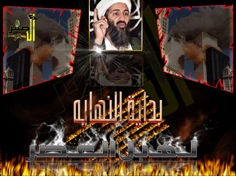
Jihadi propaganda frequently utilizes important political events or violent struggles related to Islamic communities for mobilization of recruits and support. These images draw attention to events that have helped to shape the current jihadi movement, and they allow the propagandists to reinterpret these events through their own ideological and cultural frameworks. In this case, the image makes use of the 9/11 attacks. The overall message of the image is encapsulated in the main caption that ties the disparate elements together: “bidayat al-nihaya li-hubal al-‘asr” (“the beginning of the end for the Hubal [one of the pre-Islamic idols] of our era”). These words identify the attacks of 9/11 with destruction of the idols of pre-Islamic Arabia.
The black background of the image highlights its different elements: a picture of Usama bin Ladin flanked by two (mirror image) pictures of the burning Twin Towers. Bin Ladin’s picture indicates to the viewer the group’s organizational affiliation and lends it an aura of legitimacy. Superimposed on the left picture of the burning towers is a logo containing the word “al-Asfar” (“yellow”) with a hand grenade in place of the diacritical mark on the letter fa’ and an AK 47 rifle. This is almost certainly the “logo” of the image’s creator.
Atop the first two letters is a black banner bearing the text of the shahada (Islamic testimony of faith holding that there is no god but Allah and that Muhammad is his messenger). The black banner is a joint symbol of vengeance and revolt that traces its roots to prophetic times. The image of the black flag has been used as a symbol of religious revolt and engagement in battle (i.e., jihad). In the contemporary Islamist movement, the black flag with the shahada is used to evoke notions of jihad and of reestablishing the Islamic Caliphate.
Finally, the idea of “the beginning of the end” in the caption is also expressed in the shattered view with blood red frame of the mirrored pictures. The yellow and red of the flames invoke the pain of separation and a longing to be united with God, that is, the longing for death and achievement of martyrdom. The fiery red resonates blood, passion, impulse and danger.
 Skip to content
Skip to content
